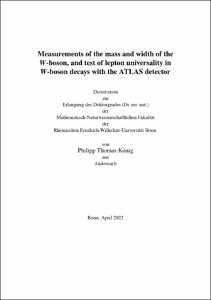König, Philipp Thomas: Measurements of the mass and width of the W-boson, and test of lepton universality in W-boson decays with the ATLAS detector. - Bonn, 2023. - Dissertation, Rheinische Friedrich-Wilhelms-Universität Bonn.
Online-Ausgabe in bonndoc: https://nbn-resolving.org/urn:nbn:de:hbz:5-70175
Online-Ausgabe in bonndoc: https://nbn-resolving.org/urn:nbn:de:hbz:5-70175
@phdthesis{handle:20.500.11811/10777,
urn: https://nbn-resolving.org/urn:nbn:de:hbz:5-70175,
author = {{Philipp Thomas König}},
title = {Measurements of the mass and width of the W-boson, and test of lepton universality in W-boson decays with the ATLAS detector},
school = {Rheinische Friedrich-Wilhelms-Universität Bonn},
year = 2023,
month = apr,
note = {The Standard Model of particle physics serves as the predominant theory of the microscopic world for many decades. Many discoveries have been predicted by this model and it still provides a good fit for a wide variety of measurements. The W-boson is the charged massive mediator of the weak force, one out of three elementary forces which can be described by a quantum field theory. The discovery of the Higgs boson in 2012 was the final piece in the puzzle of the Standard Model to explain the masses of massive bosons via the Higgs mechanism. Since its discovery in 1983, many properties of the W-boson have been studied quite intensively. Measurements of the W-boson mass and width are crucial to test the overall consistency of the Standard Model and constrain other parameters. A newly published measurement by the CDF collaboration doubts that the Standard Model can fully explain the W-boson mass as it is in clear tension with the predicted value and all other experimental measurements.
The presented thesis revisits and extends the W-boson mass measurement published by the ATLAS collaboration in 2017 based on data provided by the Large Hadron Collider in 2011 with a centre-of-mass energy of √s = 7 TeV and an integrated luminosity of ℒint = 4.59 fb−1. The main improvements are an enhanced fit methodology, an advanced background determination, and the treatment and incorporation of systematic uncertainties. This thesis presents a new measurement of the W-boson mass of mW = 80354.7 ± 15.7 MeV, where the total uncertainty is reduced by more than 10% compared to the 2017 analysis. The discrepancy with the measurement by the CDF collaboration remains an open issue for further studies. Beyond that, the first measurement of the W-boson width, ΓW, by the ATLAS collaboration is added. The result of ΓW = 2154 ± 48 MeV is the most precise single measurement so far and is still in agreement with the Standard Model prediction. Lastly, the lepton universality in the W-boson decay, Rτl, is measured to Rτl = 0.96 ± 0.11 by comparing the branching ratios of τ lepton decays to those to electrons or muons.},
url = {https://hdl.handle.net/20.500.11811/10777}
}
urn: https://nbn-resolving.org/urn:nbn:de:hbz:5-70175,
author = {{Philipp Thomas König}},
title = {Measurements of the mass and width of the W-boson, and test of lepton universality in W-boson decays with the ATLAS detector},
school = {Rheinische Friedrich-Wilhelms-Universität Bonn},
year = 2023,
month = apr,
note = {The Standard Model of particle physics serves as the predominant theory of the microscopic world for many decades. Many discoveries have been predicted by this model and it still provides a good fit for a wide variety of measurements. The W-boson is the charged massive mediator of the weak force, one out of three elementary forces which can be described by a quantum field theory. The discovery of the Higgs boson in 2012 was the final piece in the puzzle of the Standard Model to explain the masses of massive bosons via the Higgs mechanism. Since its discovery in 1983, many properties of the W-boson have been studied quite intensively. Measurements of the W-boson mass and width are crucial to test the overall consistency of the Standard Model and constrain other parameters. A newly published measurement by the CDF collaboration doubts that the Standard Model can fully explain the W-boson mass as it is in clear tension with the predicted value and all other experimental measurements.
The presented thesis revisits and extends the W-boson mass measurement published by the ATLAS collaboration in 2017 based on data provided by the Large Hadron Collider in 2011 with a centre-of-mass energy of √s = 7 TeV and an integrated luminosity of ℒint = 4.59 fb−1. The main improvements are an enhanced fit methodology, an advanced background determination, and the treatment and incorporation of systematic uncertainties. This thesis presents a new measurement of the W-boson mass of mW = 80354.7 ± 15.7 MeV, where the total uncertainty is reduced by more than 10% compared to the 2017 analysis. The discrepancy with the measurement by the CDF collaboration remains an open issue for further studies. Beyond that, the first measurement of the W-boson width, ΓW, by the ATLAS collaboration is added. The result of ΓW = 2154 ± 48 MeV is the most precise single measurement so far and is still in agreement with the Standard Model prediction. Lastly, the lepton universality in the W-boson decay, Rτl, is measured to Rτl = 0.96 ± 0.11 by comparing the branching ratios of τ lepton decays to those to electrons or muons.},
url = {https://hdl.handle.net/20.500.11811/10777}
}






